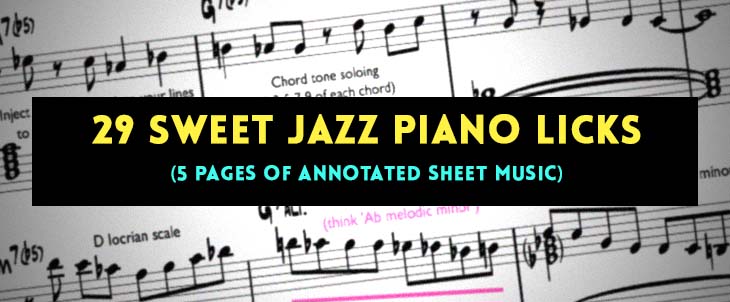Tritone Substitution Explained for Jazz Piano - Once and For All
Here's this week's jazz piano question:
"Hi Julian, I used to have a jazz teacher who would often say 'just use Tritone Substitution', but he'd never explain what 'Tritone Substitution' actually meant. I wondered if you could explain it for me, once and for all!"
Yes, absolutely!
Tritone substitution is a type of reharmonization (which means to change the song's original chords)...
Tritone Substitution is a way of reharmonizing dominant 7 (V7) chords.
Key Point:
Tritone Substitution can be used anytime you see a V7 chord in the chord sheet. It means that instead of playing the V7 chord that's written, you transpose it up a tritone:
-
So if the music says 'C7' you would play F#7 instead (because F# is a tritone above C)
-
If the music says 'F7' you would play B7 instead (because B is a tritone above F)
-
If the music says 'D7' you would play Ab7 instead (because Ab is a tritone above D)
Recommended Lesson
'Rootless Chord Voicings for Jazz Piano'
If you only learn one type of chord voicing - learn this one:
Free Resource: Download my 'Jazz Piano Chord Voicing Guide'.
Transform your playing just by adding these chord voicings to your playing.
"Why Does This Sound So Good?"
When you substitute a V7 chord this way - the music sounds mostly the same...
Because the new V7 chord has 2 of the same notes as the original V7 chord, but it also has 2 different notes...
Let's say you see C7 in the chord sheet, but you play F#7 instead:
Both C7 and F#7 contain E and Bb (just ignore the different note spelling of A# / Bb):
Meanwhile, the other 2 notes shift by a half-step, and these are what create the new sophisticated sound of tritone substitution...
Free Resource: Download my 'Jazz Piano Chord Voicing Guide' (11 pages).
Let's Apply This To A 2-5-1
Tritone Substitution works best applied to the dominant 7 (V7) chord in the middle of a ii-V-I...
It works for both the major ii-V-I and the minor ii-V-i...
Let's apply Tritone Substitution to a ii-V-I in C major:
Instead of playing D min 7 - G7 - C major 7 - you would play this:
D min 7 (D F A C) - Db7 (Db F Ab B) - C maj 7 (C E G B)
Chromatic Bass Line
An easy way to apply tritone substitutiion to a 2-5-1 is simply to move the bass note down in half-steps - D - Db - C
All you have to do is play the ii chord as normal (D min 7)...
Then move the bass note down a half-step to the b2nd and play a V7 chord (Db7)...
Finally move the bass note down one more half-step and play a major 7 chord (C maj 7).
Tweaking the Melody
When you change the dominant 7 (V7) chord, you're also changing the scale that goes with it...
The scale you'd play over Db7 is different to the scale you'd play over G7 - and this means that sometimes you'll need to tweak the melody to fit with the new chord / scale...
Over Db7 I recommend playing Db lydian-dominant scale.
So after you tritone substitute the dominant 7 (V7) chord - check to see if the notes in the original melody fit with this new Lydian-Dominant scale...
If there are any notes that don't belong in the new scale - either sharpen them or flatten them...
There's no 100% rule whether you sharpen or flatten the notes. Just use your ear to decide which sounds better. It's different for every melody.
What's Popular Now
'29 Jazz Piano Licks' sheet music

'Chord Voicing Guide for Jazz Piano'
This 11-page guide shows you chord voicings that professional Jazz pianists use.
6 pages of sheet music. Shares my top chord progressions and chord voicings.
One page cheat sheet. Shows you all common Jazz chords notated clearly:
